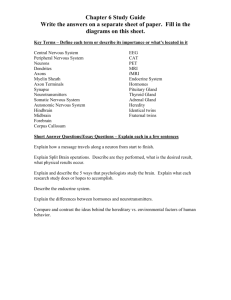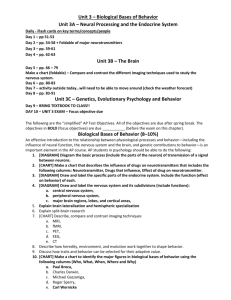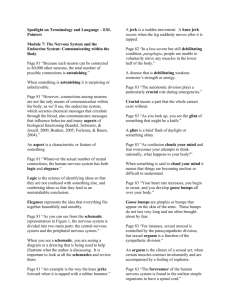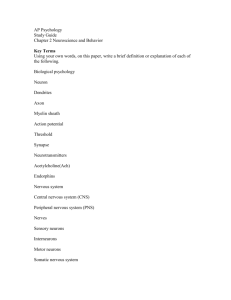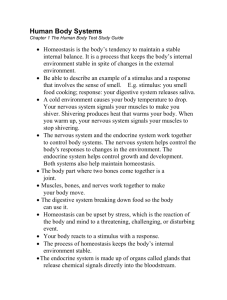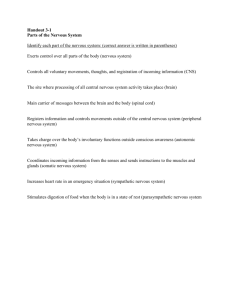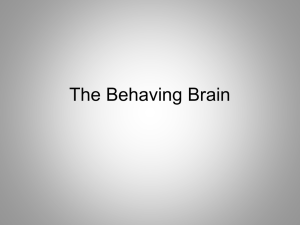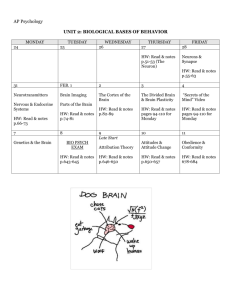Unit 9 I
advertisement
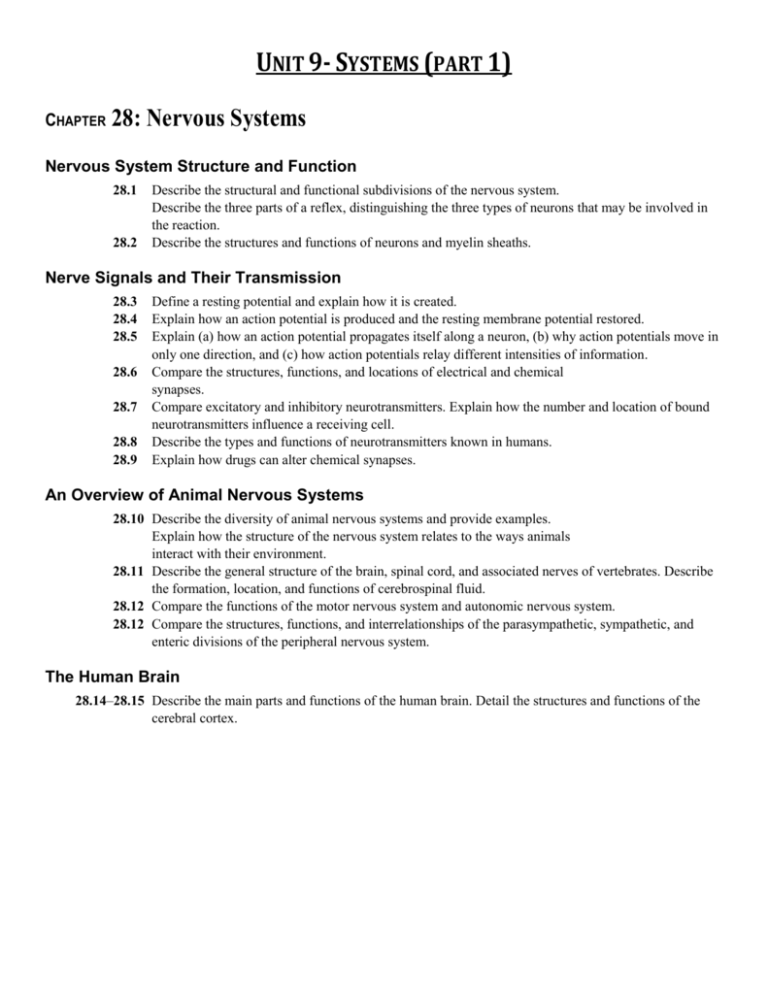
UNIT 9- SYSTEMS (PART 1) CHAPTER 28: Nervous Systems Nervous System Structure and Function 28.1 28.2 Describe the structural and functional subdivisions of the nervous system. Describe the three parts of a reflex, distinguishing the three types of neurons that may be involved in the reaction. Describe the structures and functions of neurons and myelin sheaths. Nerve Signals and Their Transmission 28.3 28.4 28.5 28.6 28.7 28.8 28.9 Define a resting potential and explain how it is created. Explain how an action potential is produced and the resting membrane potential restored. Explain (a) how an action potential propagates itself along a neuron, (b) why action potentials move in only one direction, and (c) how action potentials relay different intensities of information. Compare the structures, functions, and locations of electrical and chemical synapses. Compare excitatory and inhibitory neurotransmitters. Explain how the number and location of bound neurotransmitters influence a receiving cell. Describe the types and functions of neurotransmitters known in humans. Explain how drugs can alter chemical synapses. An Overview of Animal Nervous Systems 28.10 Describe the diversity of animal nervous systems and provide examples. Explain how the structure of the nervous system relates to the ways animals interact with their environment. 28.11 Describe the general structure of the brain, spinal cord, and associated nerves of vertebrates. Describe the formation, location, and functions of cerebrospinal fluid. 28.12 Compare the functions of the motor nervous system and autonomic nervous system. 28.12 Compare the structures, functions, and interrelationships of the parasympathetic, sympathetic, and enteric divisions of the peripheral nervous system. The Human Brain 28.14–28.15 Describe the main parts and functions of the human brain. Detail the structures and functions of the cerebral cortex. CHAPTER 25: Control of Body Temperature and Water Balance Thermoregulation 25.1 25.2 25.3 Distinguish between endotherms and ectotherms, providing examples of each. Describe the four ways that heat is gained or lost by an animal. Describe the five general categories of adaptations that help animals thermoregulate. Provide specific examples of each. Osmoregulation and Excretion 25.4 25.5 25.6 25.7 25.8 25.9 CHAPTER Describe the osmoregulatory challenges and associated adaptations of freshwater and saltwater fish, terrestrial arthropods, and terrestrial vertebrates. Describe the three ways that animals eliminate nitrogenous wastes, and the advantages and disadvantages of each method. Describe the general and specific structure of the human kidney. Explain how this organ promotes homeostasis. Describe the four major processes by which the human excretory system produces and disposes of urine. Describe the key events in the process of converting filtrate into urine in the kidneys. Explain how antidiuretic hormone contributes to homeostasis. 26: Hormones and the Endocrine System The Nature of Chemical Regulation 26.1 26.1 26.2 Compare the mechanisms and functions of the endocrine and nervous systems, noting areas of overlap. Distinguish between hormones, local regulators, pheromones, and neurotransmitters. Distinguish between the two major classes of vertebrate hormones and compare the two general mechanisms by which hormones trigger changes in target cells. The Vertebrate Endocrine System 26.3 26.4 Describe the different types of vertebrate endocrine organs noting their specific functions. Describe the functions of and interrelationships between the hypothalamus and the anterior and posterior pituitary glands. Hormones and Homeostasis 26.5 26.6 26.7 Describe the functions of the thyroid gland. Describe the symptoms of hypothyroidism, hyperthyroidism, and goiter. Explain how the thyroid and parathyroid glands maintain calcium homeostasis. Explain how insulin and glucagon manage blood glucose levels.
